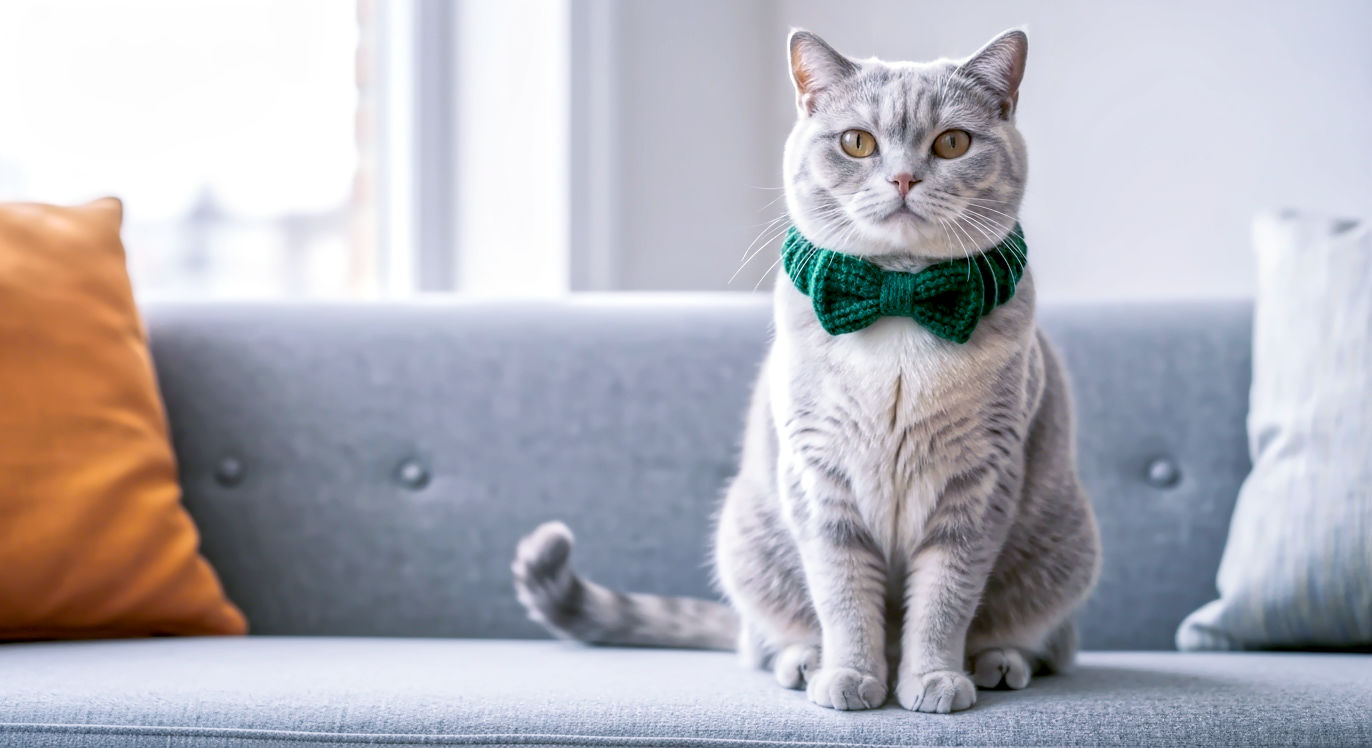More Than a Feline Fancy: The Guide to Cat Apparel in Britain
Discover the world of feline fashion in the UK. This definitive guide explores whether you should dress your cat, the top trends, and how to choose safe and comfy apparel.

This post may contain affiliate links. If you make a purchase through these links, we may earn a commission at no additional cost to you.
Let’s be honest, the very idea of dressing up a cat sounds like a recipe for disaster. We’ve all seen the videos: a moggy frozen to the spot in a tiny pirate costume, eyes wide with a mixture of confusion and pure, unadulterated fury. For most of us Brits, a cat is a creature of elegant simplicity, a furry overlord who tolerates our presence in exchange for warmth and Dreamies. The thought of putting one in a jumper seems, well, a bit daft.
And yet, if you’ve scrolled through Instagram lately, you’ll have seen it. A majestic Maine Coon sporting a tiny Aran knit jumper. A sleek Sphynx looking cosy in a fleece-lined onesie. A confident tabby cat trotting around in a smart bow tie. Feline fashion is no longer just a quirky corner of the internet; it’s a booming industry. From practical coats designed to keep hairless breeds warm to purely decorative outfits for that perfect social media snap, cat apparel is stepping out of the shadows and into the mainstream.
But is it all just a bit of fun, or is there more to it? Is it cruel, or can it actually be good for our furry friends? This guide will unravel the entire world of feline fashion. We’ll look at where this strange trend came from, what’s popular right now in the UK, and most importantly, how to do it safely and ethically. We’ll explore everything from choosing the right materials to understanding your cat’s body language, ensuring that any foray into fashion is a positive experience for everyone involved. So, put the kettle on, find a comfy chair (if your cat will let you have it), and let’s dive into the weird and wonderful world of dressing up your cat.
The Big Question: Should You Dress Your Cat?
Before we get into the nitty-gritty of tiny hats and adorable jumpers, we need to tackle the elephant in the room. Is it ever okay to put clothes on a cat? The answer isn’t a simple yes or no. It’s more of a “well, it depends.”
Cats are not small, furry humans. They’re finely tuned predators who rely on their fur for insulation, communication, and sensory information. Their skin is incredibly sensitive, and their whiskers help them navigate the world. Covering all that up can be stressful and confusing for them. Imagine someone suddenly forcing you to wear a suit of armour to do your weekly shop at Tesco – you’d probably feel a bit restricted and grumpy.
However, there are times when an item of clothing can be genuinely helpful.
When Cat Clothes Make Sense
- Warmth for Hairless or Elderly Cats: Breeds like the Sphynx, which have little to no fur, can get cold very easily, especially during a chilly British winter. A soft, well-fitted jumper can provide essential warmth and comfort. The same goes for older cats or those with certain medical conditions that make it hard for them to regulate their body temperature.
- Protection After Surgery: After an operation, vets often send pets home with a plastic cone, lovingly nicknamed the ‘cone of shame’. It stops them from licking their stitches, but it’s clumsy and can make eating and drinking difficult. A post-surgical recovery suit, which is like a little onesie for cats, can be a much more comfortable alternative. It covers the wound while allowing the cat to move around freely.
- Anxiety Reduction: Just like weighted blankets can help anxious people feel secure, some cats respond well to a snug-fitting garment, often called a ‘thundershirt’ or anxiety wrap. The gentle, constant pressure can have a calming effect during stressful situations like fireworks on Bonfire Night or a trip to the vet.
- Protection from Over-grooming: Some cats lick themselves excessively when they are stressed or have skin allergies. This can lead to bald patches and sore skin. A soft bodysuit can create a barrier, allowing the skin to heal.
When It’s a Fashion Faux Pas
The main reason not to dress your cat is simple: if they don’t like it. Forcing a cat into an outfit for your own amusement is unfair and can damage the bond of trust you have with your pet. If your cat shows any signs of distress – freezing, hiding, trying to pull the clothes off, or becoming aggressive – it’s a clear sign to stop.
Never use clothing as a substitute for proper care. A coat won’t make up for a cold house, and a costume is not a solution for boredom. Your cat’s well-being must always come first.
Reading the Signs: How to Tell if Your Cat is Unhappy
Cats are masters of subtle communication. Here’s what to look for:
- Body Language: A cat that is flattened to the ground, has its ears back, or has a twitching tail is not a happy cat.
- Freezing: Many cats will simply freeze and refuse to move when dressed up. While it might look funny, it’s a sign of fear.
- Hiding: A cat that immediately runs and hides is telling you it feels vulnerable.
- Excessive Grooming or Scratching: They might be trying to get the offending item off.
- Vocalisation: Hissing, growling, or distressed meowing are obvious red flags.
The golden rule is this: your cat’s comfort is more important than your Instagram photo.
A Brief History of Feline Finery
The idea of dressing animals isn’t new. For centuries, humans have adorned their pets. Think of dogs in regal portraits wearing ornate collars, or horses decked out in ceremonial finery. But cats have always been a bit different. Their independent and often stubborn nature meant they largely escaped being turned into fashion accessories.
The first real wave of dressing pets started in the Victorian era. Wealthy ladies in Britain and America began to treat their lapdogs like children, and a market for tiny, elaborate outfits emerged. Cats, however, were still mostly seen as working animals, valued for their rat-catching skills rather than their cuteness.
It wasn’t until the rise of the internet and social media in the 21st century that feline fashion truly took off. Platforms like YouTube and Instagram created a new kind of celebrity: the pet influencer. Cats like Grumpy Cat (Tardar Sauce) and Lil Bub became global superstars. Their owners often dressed them in cute hats or accessories, and a global audience lapped it up.
This digital trend quickly translated into a commercial market. Pet supply companies, seeing the demand, started producing clothing lines specifically for cats. What began as a niche hobby for a few dedicated owners has now become a multi-million-pound industry. In the UK, you can now find cat clothes in major pet stores like Pets at Home, on online marketplaces like Etsy, and from specialist designer brands. It’s a world away from the simple collars of the past.
The Catwalk Unveiled: Today’s Top Trends in the UK
So, what are British cat owners actually buying? The trends range from the purely practical to the utterly whimsical.
1. The Practical Jumper
This is the bread and butter of the feline fashion world. Soft, stretchy jumpers, often made from fleece or a gentle cotton knit, are the most popular item. They are designed for comfort and warmth, making them ideal for the breeds that need them most. In the UK, classic designs like Aran knit or simple striped patterns are particularly popular, perhaps echoing our own love for a cosy winter woolly.
2. The Dapper Bow Tie and Bandana
For owners who want to add a touch of style without a full outfit, the bow tie or bandana is the perfect solution. These are far less restrictive than a jumper and are generally better tolerated by most cats. They’re a simple way to make a cat look smart for a special occasion or a quick photo. You’ll find them in every pattern imaginable, from traditional tartan to quirky prints featuring fish or balls of yarn.
3. The Seasonal Sensation
Come Christmas, the shops are filled with tiny Santa hats, elf costumes, and festive jumpers for cats. The same happens at Halloween, with miniature witch hats and pumpkin-themed outfits. While these are usually intended for short-term wear and a bit of fun, it’s crucial to remember that a cat’s tolerance for a novelty costume is likely to be very low. Safety is key: avoid anything with small, dangling parts that could be chewed off and swallowed.
4. The Rise of ‘Catfluencers’ and Designer Gear
The influence of social media cannot be overstated. British ‘catfluencers’ – cats with huge followings on Instagram and TikTok – often showcase a wide range of outfits. This drives trends and creates demand for more elaborate and photogenic clothing. It has also led to a small but growing market for designer cat wear, with independent makers on platforms like Etsy creating bespoke, handmade items. These can range from tiny tweed jackets (a very British choice!) to miniature hoodies that mimic popular streetwear brands.
5. The Protective Bodysuit
Moving back to the practical side, bodysuits and recovery suits are becoming increasingly common. Vets may recommend them, and owners are realising they are a kinder alternative to the plastic cone. They are designed with function in mind, using breathable, flexible fabrics that don’t irritate a cat’s skin or stitches.
Choosing the Right Outfit: A Buyer’s Guide
If you’ve decided that a piece of clothing would benefit your cat, how do you choose the right one? Here are the key things to consider.
Fabric and Material
A cat’s skin is delicate. The wrong material can cause irritation, overheating, or allergic reactions.
- Good choices: Look for soft, natural, and breathable fabrics like cotton, fleece, or a soft jersey knit. These materials are gentle on the skin and allow for good air circulation.
- Bad choices: Avoid scratchy materials like coarse wool or synthetic fabrics like nylon that don’t breathe well. Also, steer clear of anything with lots of glitter, sequins, or beads, as these can be easily ingested.
Fit and Comfort
This is probably the most important factor. An ill-fitting garment can restrict movement, cause chafing, or even be a safety hazard.
- Measure your cat: Before you buy anything, take proper measurements. You’ll need the circumference of their neck, the circumference of the widest part of their chest (just behind the front legs), and the length from the base of their neck to the base of their tail.
- Check the size guide: Every brand is different, so always compare your cat’s measurements to the product’s size guide.
- No restrictions: The outfit should be snug enough that it won’t get caught on things, but loose enough that it doesn’t restrict movement, breathing, or their ability to go to the toilet. Your cat should be able to walk, run, jump, and groom (at least partially) without any trouble.
- Easy on, easy off: Look for clothes with simple fastenings like Velcro or snap buttons. Avoid complicated designs with lots of zips or buttons, which can be fiddly and stressful for your cat.
Safety First: The Dos and Don’ts
- DO supervise your cat at all times when they are wearing clothes.
- DON’T leave them dressed up when they are home alone. A garment could get snagged on furniture, posing a serious risk.
- DO check for any loose threads, dangling parts, or small attachments that could be a choking hazard.
- DON’T use any clothing that covers the face, ears, or whiskers. Cats need these to sense their environment.
- DO ensure the outfit doesn’t restrict their ability to use the litter tray.
- DON’T ever use dog clothes for a cat. Their body shapes are very different, and what fits a dog is unlikely to fit a cat safely or comfortably.
How to Introduce Your Cat to Clothes: A Step-by-Step Guide
If you’ve bought an item of clothing for a practical reason, you’ll need to introduce it carefully to ensure your cat accepts it. This process should be slow, patient, and filled with positive reinforcement.
Step 1: Get them used to the item. Leave the jumper or bodysuit on the floor near their favourite sleeping spot for a few days. Let them sniff it and get used to its presence. You can also place treats on it to build a positive association.
Step 2: Drape it over them. Once they are comfortable with the item, gently drape it over their back for a few seconds, without putting it on properly. Immediately give them a treat and lots of praise. Repeat this several times over a day or two.
Step 3: The first try-on. Choose a quiet time when your cat is relaxed. Gently slip the garment on. If they seem calm, immediately reward them with their favourite high-value treat (a bit of chicken or a LickiLick tube works wonders). Keep the first session very short – just a minute or two.
Step 4: Distraction is your friend. While they are wearing the item, distract them with a toy or a treat puzzle. This helps them to focus on something positive rather than the strange new thing they are wearing.
Step 5: Gradually increase the time. Over several days, gradually increase the amount of time they spend in the garment. Always end on a positive note, taking it off before they show any signs of getting stressed.
What if they hate it? If at any point your cat shows signs of serious distress, stop immediately. Don’t force it. Not all cats will tolerate clothing, and that’s perfectly fine. Their happiness is what matters most.
The DIY Option: Crafting for Your Cat
For the crafty cat owner, making your own feline fashion can be a rewarding experience. It allows you to choose the perfect fabric and get a custom fit.
Knitting and Crocheting
Knitted jumpers are a popular choice. If you’re a knitter, there are plenty of free patterns available online. The key is to use a very soft yarn – merino wool or a cotton blend is ideal. Make sure your tension is not too tight, as the garment needs to have some stretch.
Sewing
If you’re a sewer, you can adapt patterns for small dog clothes or find cat-specific ones. Fleece is a great fabric to work with as it’s soft, warm, and doesn’t fray. Always ensure any seams are smooth and flat on the inside so they don’t irritate your cat’s skin.
Safety for DIY Projects
The same safety rules apply. Avoid buttons, bows, or anything that can be chewed off. All fastenings should be secure. And always, always prioritise your cat’s comfort over the aesthetics of your creation.
The Future of Feline Fashion
What’s next for the world of cat apparel? The trend shows no signs of slowing down. We’re likely to see a few key developments:
- Smarter Textiles: We may see the development of clothes with built-in technology. Imagine a bodysuit that monitors a cat’s heart rate and temperature after surgery, or a calming wrap that emits a pheromone.
- Greater Focus on Sustainability: As consumers become more environmentally conscious, expect to see more brands using organic, sustainable materials and ethical production methods.
- More Bespoke and Custom Options: The demand for personalised and custom-fit items will likely grow, especially as 3D printing and other technologies become more accessible.
- Increased Veterinary Acceptance: As the benefits of recovery suits and anxiety wraps become more widely recognised, we can expect to see more vets recommending them as part of a treatment plan.
The Final Word
Feline fashion is a surprisingly complex topic. It sits at a strange crossroads between practicality, human creativity, and animal welfare. While the image of a cat in a silly costume can make us smile, it’s vital to remember that we are dealing with a living creature, not a doll.
The decision to dress your cat should always be made with their best interests at heart. For a hairless Sphynx shivering on a cold day, a soft jumper is an act of kindness. For a cat recovering from surgery, a protective bodysuit is a tool for healing. For a nervous cat terrified by fireworks, an anxiety wrap can be a source of comfort.
But for the majority of our furry friends, who are perfectly happy in their own beautiful fur coats, clothes are simply unnecessary. The best way to show them you love them is not with a fancy outfit, but with a clean litter tray, a full food bowl, a warm lap, and the freedom to be their wonderful, independent, and resolutely unclothed selves.
Further Reading
For more information on cat welfare and behaviour, please visit these highly respected resources:
- Cats Protection: https://www.cats.org.uk/
- RSPCA (Royal Society for the Prevention of Cruelty to Animals): https://www.rspca.org.uk/adviceandwelfare/pets/cats
- International Cat Care: https://icatcare.org/






